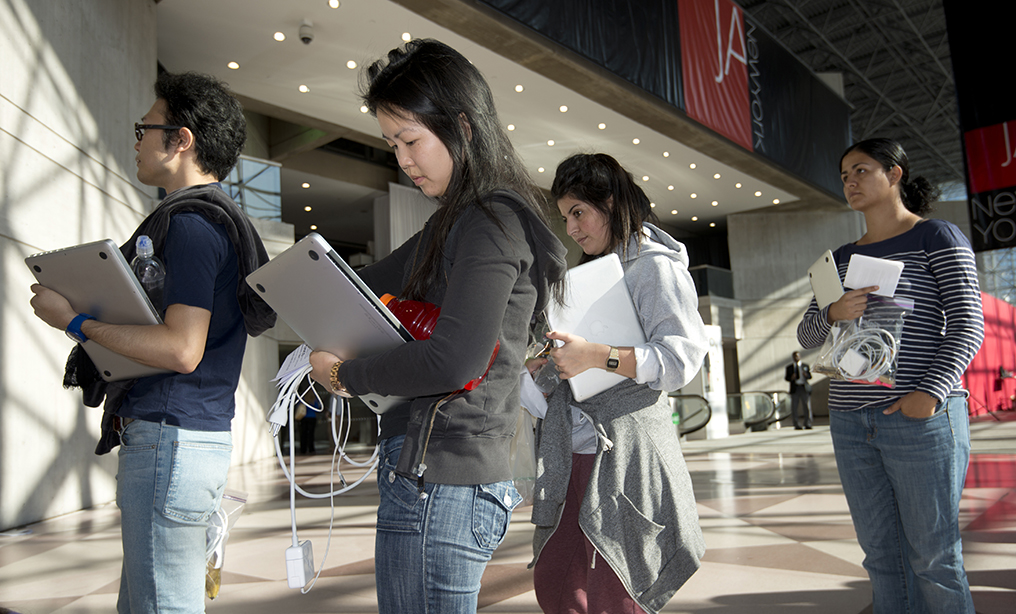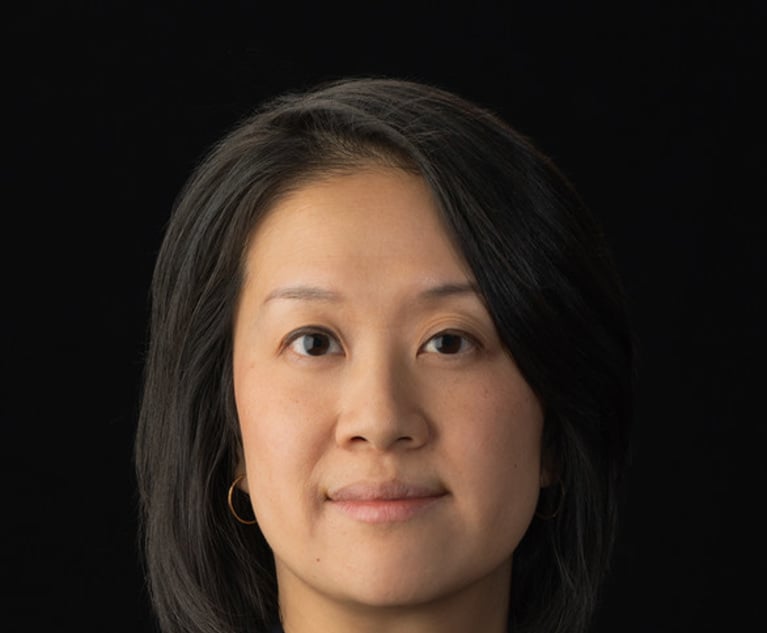NY's Transition to Uniform Bar Exam Had Little Impact on Test Performance, Report Finds
The study looked at performance on the bar exam in New York between July 2015 and July 2017. New York started administering the Uniform Bar Exam in July 2016.
August 20, 2019 at 02:59 PM
4 minute read
 Students wait in line to take the New York State bar exam at the Jacob Javits Center in Manhattan (Photo: Monika Kozak/NYLJ)
Students wait in line to take the New York State bar exam at the Jacob Javits Center in Manhattan (Photo: Monika Kozak/NYLJ)New York’s transition to the Uniform Bar Examination from a statewide exam three years ago has had little impact on the performance of prospective attorneys taking the test, a report from the National Conference of Bar Examiners said Tuesday.
Instead, the small increase in performance among candidates over a three-year period appeared to be attributed to how well they did in their academic career, the report said.
The study looked at performance on the bar exam in New York between July 2015 and July 2017. New York started administering the Uniform Bar Exam in July 2016.
When the New York Court of Appeals, the state’s highest court, voted to transition the state to the Uniform Bar Exam four years ago, New York became the 16th state to do so. As of May, that number had doubled.
The National Conference of Bar Examiners, in the three-year study, looked at performance on the bar exam by race, ethnicity, gender, and other background characteristics. They considered how performance in undergraduate education, law school, and the LSAT correlated with their results on the exam, for example.
Over the year following the first time the Uniform Bar Exam was administered to prospective lawyers in New York, pass rates increased, according to the report released Tuesday. But that likely had nothing to do with the new exam, the report said.
“This is not to say that the pattern was perfect, but background characteristics certainly explained at least a portion of the improvement in bar exam scores after UBE adoption, indicating that improvement in bar exam scores was likely not due to the UBE,” an executive summary of the report said.
Pass rates increased marginally over the three-year period, according to the report.
The bar exam is administered in February and July in New York. Pass rates for the February test-takers increased from 40.5% to 43.8% between 2016 and 2017, the report said. Pass rates in July, meanwhile, increased from 60.9% to 68.5% between 2015 and 2017.
Average bar exam scores increased from 258.20 in February 2016 to 260.62 the following year, and 273.52 in July 2015 to 281.67 in July 2017, according to the report.
Scores and pass rates tended to increase for each group, separated by gender and race/ethnicity, between each one-year period, according to the report.
One notable exception, the report said, was when scores and pass rates for the black/African American group increased less than other groups between July 2015 and July 2016, but then increased more than any other group in July 2017.
Statistically, the Caucasian/white group tended to have the highest average scores on the bar exam, followed by the Asian/Pacific Islander group. Test-takers that identified as male tended to have higher pass rates than their female counterparts, the report said.
Chief Judge Janet DiFiore said in a statement with the report that the amount of data collected through the study, which is nearly 300 pages, was important for the state court system to understand because of the impact of transitioning to a new bar exam.
“I want to thank the National Conference of Bar examiners for conducting this careful and exhaustive study on our behalf,” DiFiore said. “This is an important component in our examination of the impact of adoption of the UBE on candidates seeking admission to the bar in New York.”
The full report is available on the New York State Board of Law Examiners website.
READ MORE:
‘Old MacDonald’ Had A Tort Claim: NY Judge Remixes Nursery Rhymes for Bar Prep
Minds Over Matters: An Examination of Mental Health in the Legal Profession
This content has been archived. It is available through our partners, LexisNexis® and Bloomberg Law.
To view this content, please continue to their sites.
Not a Lexis Subscriber?
Subscribe Now
Not a Bloomberg Law Subscriber?
Subscribe Now
NOT FOR REPRINT
© 2025 ALM Global, LLC, All Rights Reserved. Request academic re-use from www.copyright.com. All other uses, submit a request to asset-and-logo-licensing@alm.com. For more information visit Asset & Logo Licensing.
You Might Like
View All

Courts Beginning to Set Standards for Evidence Relying Upon Artificial Intelligence
4 minute read
NY Judge Admonished Over Contributions to Progressive Political Causes

Attorneys ‘On the ‘Move: Morrison Cohen Expands White Collar Practice; O’Melveny Brings Back Corporate Finance Partner
6 minute readTrending Stories
- 1Public Notices/Calendars
- 2Monday Newspaper
- 3Judicial Ethics Opinion 24-98
- 4'It's Not Going to Be Pretty': PayPal, Capital One Face Novel Class Actions Over 'Poaching' Commissions Owed Influencers
- 511th Circuit Rejects Trump's Emergency Request as DOJ Prepares to Release Special Counsel's Final Report
Who Got The Work
Michael G. Bongiorno, Andrew Scott Dulberg and Elizabeth E. Driscoll from Wilmer Cutler Pickering Hale and Dorr have stepped in to represent Symbotic Inc., an A.I.-enabled technology platform that focuses on increasing supply chain efficiency, and other defendants in a pending shareholder derivative lawsuit. The case, filed Oct. 2 in Massachusetts District Court by the Brown Law Firm on behalf of Stephen Austen, accuses certain officers and directors of misleading investors in regard to Symbotic's potential for margin growth by failing to disclose that the company was not equipped to timely deploy its systems or manage expenses through project delays. The case, assigned to U.S. District Judge Nathaniel M. Gorton, is 1:24-cv-12522, Austen v. Cohen et al.
Who Got The Work
Edmund Polubinski and Marie Killmond of Davis Polk & Wardwell have entered appearances for data platform software development company MongoDB and other defendants in a pending shareholder derivative lawsuit. The action, filed Oct. 7 in New York Southern District Court by the Brown Law Firm, accuses the company's directors and/or officers of falsely expressing confidence in the company’s restructuring of its sales incentive plan and downplaying the severity of decreases in its upfront commitments. The case is 1:24-cv-07594, Roy v. Ittycheria et al.
Who Got The Work
Amy O. Bruchs and Kurt F. Ellison of Michael Best & Friedrich have entered appearances for Epic Systems Corp. in a pending employment discrimination lawsuit. The suit was filed Sept. 7 in Wisconsin Western District Court by Levine Eisberner LLC and Siri & Glimstad on behalf of a project manager who claims that he was wrongfully terminated after applying for a religious exemption to the defendant's COVID-19 vaccine mandate. The case, assigned to U.S. Magistrate Judge Anita Marie Boor, is 3:24-cv-00630, Secker, Nathan v. Epic Systems Corporation.
Who Got The Work
David X. Sullivan, Thomas J. Finn and Gregory A. Hall from McCarter & English have entered appearances for Sunrun Installation Services in a pending civil rights lawsuit. The complaint was filed Sept. 4 in Connecticut District Court by attorney Robert M. Berke on behalf of former employee George Edward Steins, who was arrested and charged with employing an unregistered home improvement salesperson. The complaint alleges that had Sunrun informed the Connecticut Department of Consumer Protection that the plaintiff's employment had ended in 2017 and that he no longer held Sunrun's home improvement contractor license, he would not have been hit with charges, which were dismissed in May 2024. The case, assigned to U.S. District Judge Jeffrey A. Meyer, is 3:24-cv-01423, Steins v. Sunrun, Inc. et al.
Who Got The Work
Greenberg Traurig shareholder Joshua L. Raskin has entered an appearance for boohoo.com UK Ltd. in a pending patent infringement lawsuit. The suit, filed Sept. 3 in Texas Eastern District Court by Rozier Hardt McDonough on behalf of Alto Dynamics, asserts five patents related to an online shopping platform. The case, assigned to U.S. District Judge Rodney Gilstrap, is 2:24-cv-00719, Alto Dynamics, LLC v. boohoo.com UK Limited.
Featured Firms
Law Offices of Gary Martin Hays & Associates, P.C.
(470) 294-1674
Law Offices of Mark E. Salomone
(857) 444-6468
Smith & Hassler
(713) 739-1250






